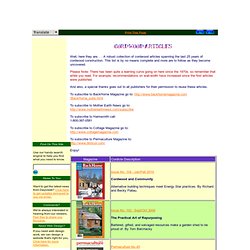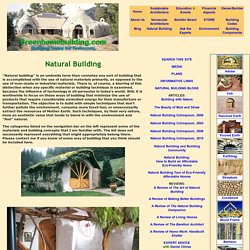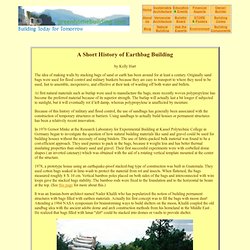

Electroculture Pyramide - Utiliser une pyramide pour les plantes. Gaia. Semi sous couvert végétal. Design et Technique. Échanges sur la permaculture. Four-solaire.iguane.org - Photos du montage du four solaire atominique. La Maison. TOITURE. Cal-Earth - The California Institute of Earth Art and Architecture. Organic Gardening, Modern Homesteading, Renewable Energy, Green Homes, DIY Projects – MOTHER EARTH NEWS.
Cordicles. Well, here they are. . .

A robust collection of cordwood articles spanning the last 25 years of cordwood construction. This list is by no means complete and more are to follow as they become uncovered. Please Note: There has been quite a learning curve going on here since the 1970s, so remember that while you read. For example, recommendations on wall-width have increased since the first articles were published. And also, a special thanks goes out to all publishers for their permission to reuse these articles. ENCYCLOPEDIA OF ALTERNATIVE ENERGY AND SUSTAINABLE LIVING. Earth-sheltered home. Also known simply as an earth home, a dwelling that is partially or totally underground (see underground home) or that has earth berms around some or all of its exterior walls (see bermed earth-sheltered home).

Earth-sheltered homes can be tailored to a wide range of climates and a variety of types of building sites – even flat ones. Combined with passive solar design, an earth-sheltered home can save tens of thousands of dollars in fuel bills over a lifetime. Earth-sheltered homes are comfortable, affordable and energy efficient. And, if thoughtfully designed, they allow in plenty of natural light and are far less of an imposition on the landscape than conventional above-ground houses. They also led themselves to innovative ideas in design and, in particular, the use of organic architectures including curving walls and ceilings that are more satisfying and harmonious as human dwellings. Use a 2-Liter Bottle as a 50 Watt Light Bulb lightbulb hack. Earthship Biotecture Green Buildings - Earthship Biotecture. Natural Building Techniques. This program offers a wealth of information about construction details and other considerations.

It covers adobe block construction, piled adobe (similar to cob), rammed earth, both load-bearing and post and beam strawbale, earthships, earth-sheltering, cordwood, thin-shelled concrete domes, papercrete, earthbags, hybrid structures, and recycling various containers for housing. $29.95 The books shown below are arranged according to when they were published, with the most recent ones at the top. If you click on one of the images you will be taken to a page at Amazon.com where you can find out more about the book. If you end up buying one of them, greenhomebuilding.com will receive a small commission that will help cover the cost of maintaining this website.
Thanks for your patronage. This is a 2 bedroom, 1 story, 1725 sf (to the outside) house that is designed around the traditional hogan concept of Southwestern native Americans. Home Site Map STORE For Email contact go to About Us. Article about the history of earthbag building. A Short History of Earthbag Building by Kelly Hart The idea of making walls by stacking bags of sand or earth has been around for at least a century.

Originally sand bags were used for flood control and military bunkers because they are easy to transport to where they need to be used, fast to assemble, inexpensive, and effective at their task of warding off both water and bullets. At first natural materials such as burlap were used to manufacture the bags; more recently woven polypropylene has become the preferred material because of its superior strength. The burlap will actually last a bit longer if subjected to sunlight, but it will eventually rot if left damp, whereas polypropylene is unaffected by moisture. A Low Impact Woodland Home. Papercrete. Papercrete is a construction material which consists of re-pulped paper fiber with Portland cement or clay and/or other soil added.

First patented in 1928, it was revived during the 1980s. Although perceived as an environmentally friendly material due to the significant recycled content, this is offset by the presence of cement. The material lacks standardisation, and proper use therefore requires care and experience. Eric Patterson and Mike McCain, who have been credited with independently "inventing" papercrete (they called it "padobe" and "fibrous cement"), have both contributed considerably to research into machinery to make it and ways of using it for building. [citation needed] Manufacture[edit] The paper to be used can come from a variety of sources. A typical homemade mixer uses a small electric motor mounted directly on a shaft with two four-inch square blades attached, resembling milk shake maker.
Paperpulp may be added to clay soils where sand is not available. Mr. 2011 Papercrete DVDs - Papercrete Workshops - Papercrete Research. Natural Building Techniques: Papercrete. Taylor Publishing & Elk River Press - Home. Natural Building Colloquium. The Honey House KAKI HUNTER and DONI KIFFMEYER After a hands-on workshop taught by architect Nader Khalili, we returned home inspired to build our first earthbag project.

We started with simple, linear, buttressed exterior walls, graduated to serpentine garden walls, progressed to a small dome and are now finishing a larger dome with a vaulted entry way and big sunny arched windows. This last project turned into a casual workshop inviting people to learn "Flexible Form Rammed Earth," A term we now use that we feel best describes this construction method. "Flexible Form Rammed Earth (F.F.R.E.) " is a free-form version of rammed earth construction. Cob (material) Building a wall out of cob.

Cob, cobb or clom (in Wales) is a natural building material made from sand, clay, water, some kind of fibrous or organic material (straw) and earth. Cob is fireproof, resistant to seismic activity,[1] and inexpensive. It can be used to create artistic, sculptural forms and has been revived in recent years by the natural building and sustainability movements. In technical building and engineering documents such as the Uniform Building Code, cob may be referred to as an "unburned clay masonry" when used in a structural context.
Cob Building/ earth building course with Edwards Eco Building More Building with Cob Cob Building with Groundworks.